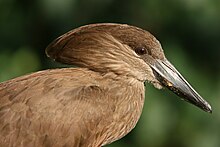Hamerkop
| Hammerkop | |
|---|---|
| File:Hammerkop2.jpg | |
| Scientific classification | |
| Kingdom: | |
| Phylum: | |
| Class: | |
| Order: | |
| Family: | Scopidae Bonaparte, 1849
|
| Genus: | Scopus Brisson, 1760
|
| Species: | S. umbretta
|
| Binomial name | |
| Scopus umbretta Gmelin, 1789
| |
The Hammerkop (Scopus umbretta), also known as Hamerkop, Hammerhead, Hammerhead stork, Umbrette, Umber bird, or Anvilhead, is a medium-sized (56 cm) bird with a long shaggy crest. The shape of its head with a curved bill and crest at the back is reminiscent of a hammer, hence its name. Its plumage is a drab brown all over.

It occurs in Africa south of the Sahara, Madagascar and southwest Arabia in all wetland habitats, including rice paddies. Normally it is seen alone or as a pair. The food is typical of long-legged wading birds, including fish, frogs, rodents and similar small animals.
It builds a huge haystack-like stick nest nearly 2 m across in a tree fork, and lays 3 to 6 eggs. The nest is reused each year, getting larger and larger as the Hammerkop renovates it. The entrance to the nest remains at the bottom, to deter potential predators. The Hammerkop has a noisy call.
The Hamerkop is usually included in the Ciconiiformes, but might be closer to the Pelecaniformes.[2] It constitutes a family (Scopidae) and genus (Scopus) all on its own because of its unique characteristics.
Media
-
Front view
-
Another front view
-
Side view
-
Fluffing its feathers
References
- ^ Template:IUCN2006 Database entry includes justification for why this species is of least concern
- ^ Van Tuinen, Marcel (2001). "Convergence and divergence in the evolution of aquatic birds" (PDF). Proceedings of the Royal Society of London. 26 (8): 1345–1350.
{{cite journal}}: Unknown parameter|coauthors=ignored (|author=suggested) (help)
External links
- Hamerkop videos on the Internet Bird Collection





